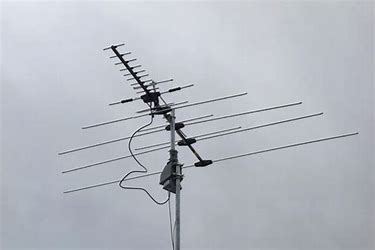This recent excursion into Audio/Visual equipment and electronics has gotten me looking around to the science of antennas. Boy let me tell you that from what is out there, this hobby is either a cult or dominated socially challenged individuals. It is very hard to get concise, novice level advice that isn’t filled with technical jargon.
The words cheap or DIY antenna conjure up some pretty ‘hacky’ results. Some of the first results found in such a search do bring up results, but they are very mixed up in technical details that don’t matter and use some techniques and materials that are lab worthy, but not something that will stand the test of time. I want to qualify before I get too deep that I am not an expert in the science nor do I have much (if any) experience in building antennas.
First, how do radio signals work? Each radio station has a frequency that they broadcast their signal. For example, 101.5 MHz is one particular radio station address. So what is a MHz?
- M – Mega or 1,000,000
- Hz – Hertz, unit of length of the radio signal in one second

That means that for 101.5, there are 101,500,000 waves in one second. All signals have an assigned band of frequencies that they can operate in. So, the smaller the number (of hertz), the the taller the wave is (because you are measuring the length in one second). Here are some examples from shortest to longest.
- AM 535-1605 KHz (remember that kilo is 1,000)
- FM 88-108 MHz
- VHF 174-216 MHz
- UHF 470-806 MHz
This is why antennas need to be specific size (length) to the signal that they are trying to capture. They are optimized for a frequency or band of frequencies, like a TV antenna. Also when looking at an outdoor TV antenna, notice that each conductor is a different length. This is to try and capture all of the frequencies that are available in the range.

So a dipole is a type of antenna that has a specific length of conductor that is optimized for one frequency. The most familiar dipole is the ‘rabbit ears’ type antenna. I wont go into all of the science on this version, however the principle is that you extend or adjust the length of the antenna and orientation to maximize reception of a particular frequency.
The length of a dipole is determined by matching the size of the radio wave to the frequency that you are trying to capture. Looking at the picture above, it would be an antenna that is one of the horizontal members sized for a specific frequency. There are calculators online that you can use to determine how long your antenna needs to be in order to capture the frequency you are looking for.

There is also a concept of directional or unidirectional. Directional means that your orientation of the antenna matters in the reception ability. Dipoles are directional, but it seems like the features where it matters, like Ham radio are not really affected for FM reception. We will find out.
The good news about all of this is that this is a novice look at all of this, so if you decide to build a dipole for FM, and your antenna is between 4’3″-5’3″ feet, you should be able to get most of the available stations. I will be posting about what I think makes a good antenna in the near future as I finish building it.
Recent Comments